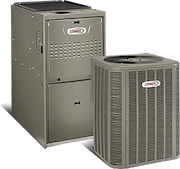
For most St. Louis homeowners, the top priority of their HVAC system is to provide warm or cooled air. That is definitely important to the comfort of the home, but one must not forget how much an air conditioner or furnace is responsible for indoor air quality.
An air-conditioner especially must “condition” the air, as its name implies. What this means is taking moisture out of the room so that mold and mildew are not apt to grow. Forced air systems also must be maintained so that they do not spread dust and dander throughout the house and cause poor air quality and difficulty breathing.
Despite the role of your HVAC system with healthy breathing, some people still are not in tune with vital indoor air quality facts and information. Dust mites and other allergens are largely hidden, and thus sometimes an afterthought – putting those indoor air quality facts into black and white will hopefully reiterate just how important a healthy living space really is.
Indoor Air Quality Fact #1: Indoor Air Quality is a Top 5 Environmental Risk According to the EPA
We all know how harmful smog and pollution in the outdoor environment is but it may surprise you that the EPA ranks your home about just as dangerous. The presence of carbon monoxide, radon, VOCs, cleaning chemicals, mold, dust mites, pollen, and dander makes your home one of the top 5 risks according to the EPA. An important indoor air quality fact is that the air inside your home is up to 5X more polluted than outside air.
Air Quality Fact #2: People are Indoors on Average of 90% of the Time
Compounding the problems of indoor air being so unhealthy is the indoor air quality fact that people spend nearly 90% of their time inside. This does not mean in your house, but indoors of some sort whether it be at school, work, shopping, etc.
Indoor Air Quality Fact #3: Asthma Cases Are Still on the Rise

One of the most disheartening indoor air quality facts is that asthma is on the rise. For the past couple decades, experts thought that this was actually because our air was too clean – kids were not being exposed to enough low-level contaminants at a young age so their immune systems did not train themselves. However, now they are pointing towards poor indoor air quality as the culprit.
Indoor Air Quality Fact #4: The Problems of Poor Air Go Beyond “Irritants”
So you think you can cough your way through a dirty house from time to time because it is nothing more than annoying? The truth is indoor air contaminants carry with them very severe problems such as lung cancer and heart problems. These particles are breathed into your body and gain access to your blood stream, causing damage to virtually everything they come in contact with.
Indoor Air Quality Fact #5: You Probably Have Indoor Air Quality Problems
Another one of the startling indoor air quality facts is that basically every home is at risk. Just look at the sources of contaminants:
- Combustion including stoves, gas furnaces, fireplaces, and smoking
- Building materials in your home from the flooring to the walls, ceiling, insulation, paint, etc.
- Cleaning products, hair spray, and other chemical sources
- “Organic” sources such as radon, pollen, outdoor smog, pesticides, pet dander, hair, skin cells, dust mites, etc.
Because of the many possible sources for indoor pollutants, one cannot stress enough the importance of learning and understanding indoor air quality facts, and how they affect your home. With an understanding of these facts and information, you can begin to learn what you can do to maintain positive indoor air quality in your home.
Learn More Indoor Air Quality Facts
For tips on reducing indoor air pollution and to learn more, call the St. Louis heating & air conditioning experts at Galmiche & Sons today! We’ve been helping St. Louis residents improve their indoor air quality for years, and can help you do the same.











